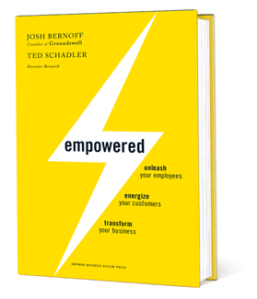
I have a lot of passion for the end user experience, and (prior to this conference) met through email an excellent user experience person in IT at HP, Sarah Deane. I’m so impressed with her that I have promised myself I’ll use her on any IT project I’m involved in. Thankfully, she’s already being utilized with my current project: implementing Sharepoint 2010 for 300K+ end users within the HP ecosystem.
After the last presentation, I got to meet (in person) Dani Weinstein, who’s working hard setting the standard for HP customer support. We had a tiny conversation about the customer experience before this session started, but it was a good precursor for an inquiry as to how we can actually design things so that people use them in a way that might actually be valuable. I was in for a surprise with Andy Budd, though.
I’m not sure how much of Andy’s presentation I can actually share. Some of it is not rated for this blog. However, there’s standing room only in the Empire East room at the Web 2.0 Expo, all waiting to be entranced by this guy.
Who is Andy Budd?
… an interaction designer and web standards developer from Brighton, England. As the user experience lead at Clearleft (clearleft.com), Andy spends his time helping clients improve their customers online experience.
Andy is a regular speaker at international design events such as SXSW, An Event Apart and Web Design World. He also runs the popular dConstruct conference, which takes place in Brighton every year (dconstruct.org). Andy has helped judge several international design awards and currently sits on the advisory board for .Net magazine. Andy wrote the best selling book, CSS Mastery (cssmastery.com) and blogs at andybudd.com.
Never happier than when he’s diving some remote tropical atoll, Andy is a qualified PADI dive instructor and retired shark wrangler.
I can’t wait to meet him and talk about shark wrangling. Anyway, the summary of the presentation is this:
Every day we make thousands of small decisions, be it which cereal to buy or which pension scheme to invest in. We like to think that these decisions are conscious and rational. However the latest advances in cognitive psychology, behavioural economics and neuroscience show that this is often not the case. We rely heavily on shortcuts and “cognitive biases” which make us highly susceptible to influence. By using the concept of “choice architecture”, smart designers can reduce cognitive load and nudge people in a direction of their choosing. A direction that is beneficial to both their users and their clients.
In this session Andy will look at some of the most common “cognitive biases” and how concepts of trust, reciprocity, social proof and liking are used by sales people and marketers around the world to persuade people to do their bidding. Using examples ranging from architecture to menu design, Andy will show how these time honoured techniques can be employed on the web. The result is not only a site that looks good and is free of usability errors; it’s a site that’s designed around the way we think and optimised for the maximum return on investment
So if you’re a designer looking to hone their skills or a business owner wanting to increase registrations and site loyalty, this session will teach you everything you need to know to become a master in online persuasion.
I’m a bit tired of hearing the phrase “tribe”, but there was some great discussion about how different companies utilize design to “persuade” their customers to do exactly what they want them to do. Having pulled many slot machine levers, I understand how all the lights and action and timing can pull you in and keep you in. But, I wasn’t yet clear on how this applied to me, as an IT person in end user services at a very large organization.
Then, he started talking about emotional pull and the whole world of persuasion, that makes us better (more intentional) designers, more efficient, and creating better experiences for our customers. That struck a cord with me.
Unfortunately, his slides aren’t posted. So, I’m off to the next session!
<Updated: Andy Budd graciously shared his slideware in the comments.>


